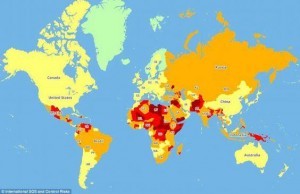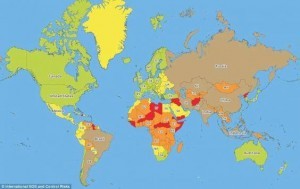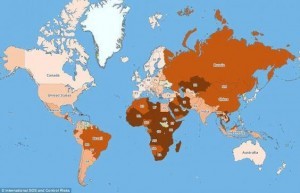Travelling to any country in the world always comes with its own risks.
How easy is it to travel around? Are there any security threats? What health precautions should you take?
These are all important questions that should be addressed before you step aboard a plane, train or automobile.
A set of new interactive maps have been released in order to provide this essential information at the touch of a button.
The maps come from International SOS and Control Risks and claim to detail the medical, security and road safety hazards every country in the world faces.
The first map evaluates the medical risks around the globe, claiming that large parts of Africa and Asia are at dangerous threat to a traveller’s health.
Meanwhile, Europe, North America, Chile, Uruguay, South Africa, Japan, New Zealand and Australia are all reportedly considered to be safe.
(This map, by International SOS and Control Risks, shows the places most likely to put your health at risk. Low risk countries are marked in green, medium in yellow, high in orange, very high in red and those that have a ‘rapidly developing variable risk’, such as Brazil and Russia, are marked in light brown.)
Next are security risks; International SOS and Control Risks say major countries like the United States, Canada, United Kingdom, China, Japan, Australia and most of Europe are deemed to be low risk.
High to extreme risk include large parts of Africa, Afghanistan, Pakistan, Syria, Yemen, Venezuela, parts of the Ukraine, parts of India and Papua New Guinea.
(This map shows which countries have the highest and lowest security risks, with those that have an insignificant risk marked in light green, ‘low’ risk countries are marked in yellow, medium in brown, high in red and extreme, such as Libya, in dark red.)
Finally is road safety, where Africa is once again ranked highly, with nearly the entire continent falling into the “High” or “Very High” category in terms of risk.
Other countries and regions reportedly posing a large threat to travellers on the road include Russia, Mongolia, China, Iran, Kazakhstan, Brazil, Bolivia and Paraguay.
(This map shows countries categorised according to road safety risks, with very low marked in pale pink, low in very light brown, moderate in a slightly darker shade and high and very high risk countries picked out using even darker browns.)
All of their findings for medical and security risks were based on ratings from November 2017.
Road safety results were obtained courtesy of the Global Status Report on Road Safety by the World Health Organization, 2016.
If you would like to learn more take a look at the interactive map HERE.
Source: indy100.com
Ask me anything
Explore related questions







